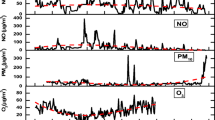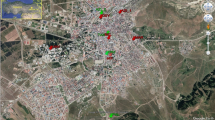Abstract
Background, Aim and Scope
Air quality is an field of major concern in large cities. This problem has led administrations to introduce plans and regulations to reduce pollutant emissions. The analysis of variations in the concentration of pollutants is useful when evaluating the effectiveness of these plans. However, such an analysis cannot be undertaken using standard statistical techniques, due to the fact that concentrations of atmospheric pollutants often exhibit a lack of normality and are autocorrelated. On the other hand, if long-term trends of any pollutant's emissions are to be detected, meteorological effects must be removed from the time series analysed, due to their strong masking effects.
Materials and Methods
The application of statistical methods to analyse temporal variations is illustrated using monthly carbon monoxide (CO) concentrations observed at an urban site. The sampling site is located at a street intersection in central Valencia (Spain) with a high traffic density. Valencia is the third largest city in Spain. It is a typical Mediterranean city in terms of its urban structure and climatology. The sampling site started operation in January 1994 and monitored CO ground level concentrations until February 2002. Its geographic coordinates are W0º22'52\ N39º28'05\ and its altitude is 11 m. Two nonparametric trend tests are applied. One of these is robust against serial correlation with regards to the false rejection rate, when observations have a strong persistence or when the sample size per month is small. A nonparametric analysis of the homogeneity of trends between seasons is also discussed. A multiple linear regression model is used with the transformed data, including the effect of meteorological variables. The method of generalized least squares is applied to estimate the model parameters to take into account the serial dependence of the residuals of this model. This study also assesses temporal changes using the Kolmogorov-Zurbenko (KZ) filter. The KZ filter has been shown to be an effective way to remove the influence of meteorological conditions on O3 and PM to examine underlying trends.
Results
The nonparametric tests indicate a decreasing, significant trend in the sampled site. The application of the linear model yields a significant decrease every twelve months of 15.8% for the average monthly CO concentration. The 95% confidence interval for the trend ranges from 13.9% to 17.7%. The seasonal cycle also provides significant results. There are no differences in trends throughout the months. The percentage of CO variance explained by the linear model is 90.3%. The KZ filter separates out long, short-term and seasonal variations in the CO series. The estimated, significant, long-term trend every year results in 10.3% with this method. The 95% confidence interval ranges from 8.8% to 11.9%. This approach explains 89.9% of the CO temporal variations.
Discussion
The differences between the linear model and KZ filter trend estimations are due to the fact that the KZ filter performs the analysis on the smoothed data rather than the original data. In the KZ filter trend estimation, the effect of meteorological conditions has been removed. The CO short-term component is attributable to weather and short-term fluctuations in emissions. There is a significant seasonal cycle. This component is a result of changes in the traffic, the yearly meteorological cycle and the interactions between these two factors. There are peaks during the autumn and winter months, which have more traffic density in the sampled site. There is a minimum during the month of August, reflecting the very low level of vehicle emissions which is a direct consequence of the holiday period.
Conclusions
The significant, decreasing trend implies to a certain extent that the urban environment in the area is improving. This trend results from changes in overall emissions, pollutant transport, climate, policy and economics. It is also due to the effect of introducing reformulated gasoline. The additives enable vehicles to burn fuel with a higher air/fuel ratio, thereby lowering the emission of CO. The KZ filter has been the most effective method to separate the CO series components and to obtain an estimate of the long-term trend due to changes in emissions, removing the effect of meteorological conditions.
Recommendations and Perspective
Air quality managers and policy-makers must understand the link between climate and pollutants to select optimal pollutant reduction strategies and avoid exceeding emission directives. This paper analyses eight years of ambient CO data at a site with a high traffic density, and provides results that are useful for decision-making. The assessment of long-term changes in air pollutants to evaluate reduction strategies has to be done while taking into account meteorological variability.
Similar content being viewed by others
Author information
Authors and Affiliations
Corresponding author
Rights and permissions
About this article
Cite this article
Capilla, C. Analysis of the Trend and Seasonal Cycle of Carbon Monoxide Concentrations in an Urban Area (4 pp). Env Sci Poll Res Int 14 (Suppl 1), 19–22 (2007). https://doi.org/10.1065/espr2006.09.342
Received:
Accepted:
Published:
Issue Date:
DOI: https://doi.org/10.1065/espr2006.09.342




